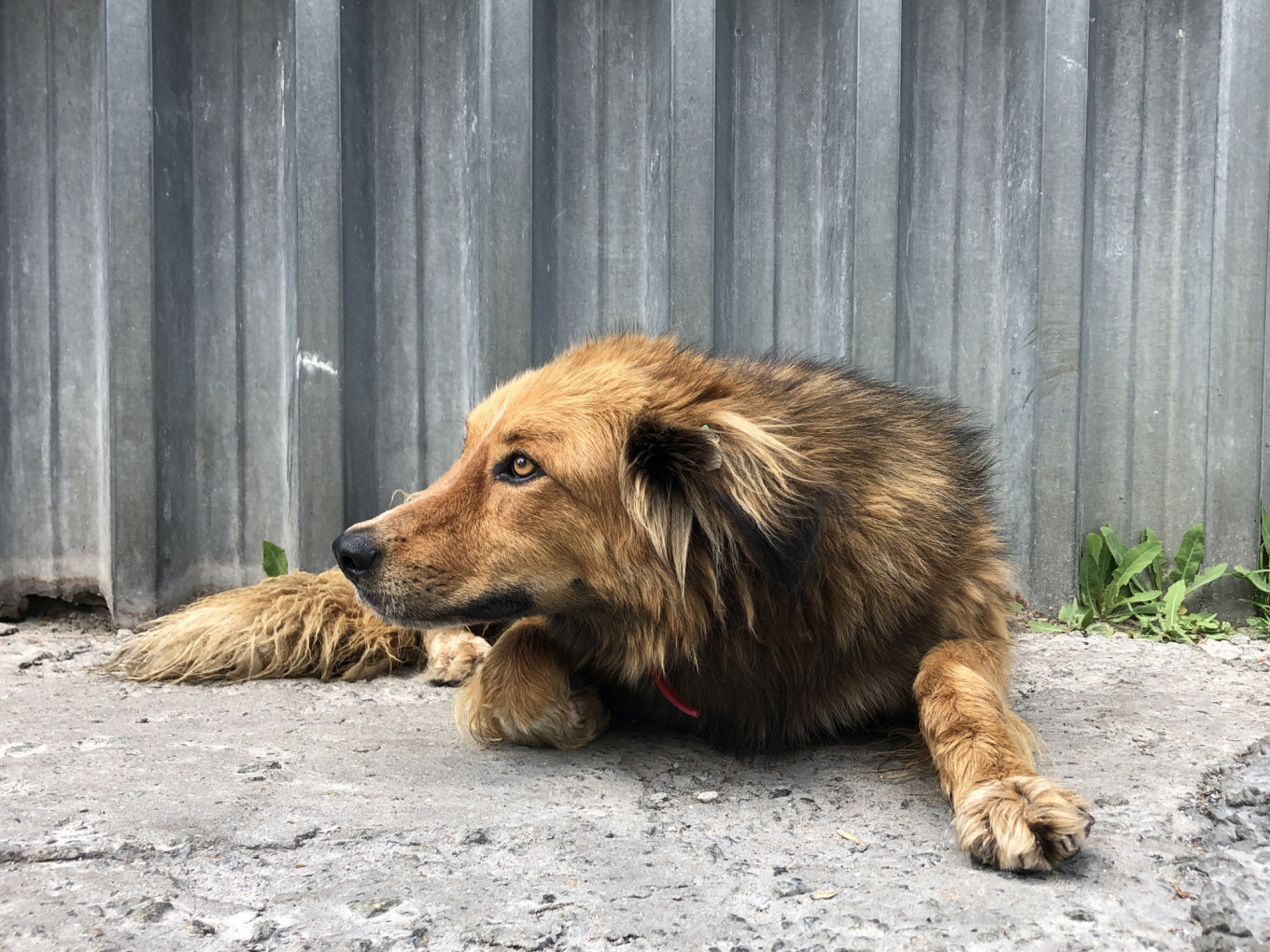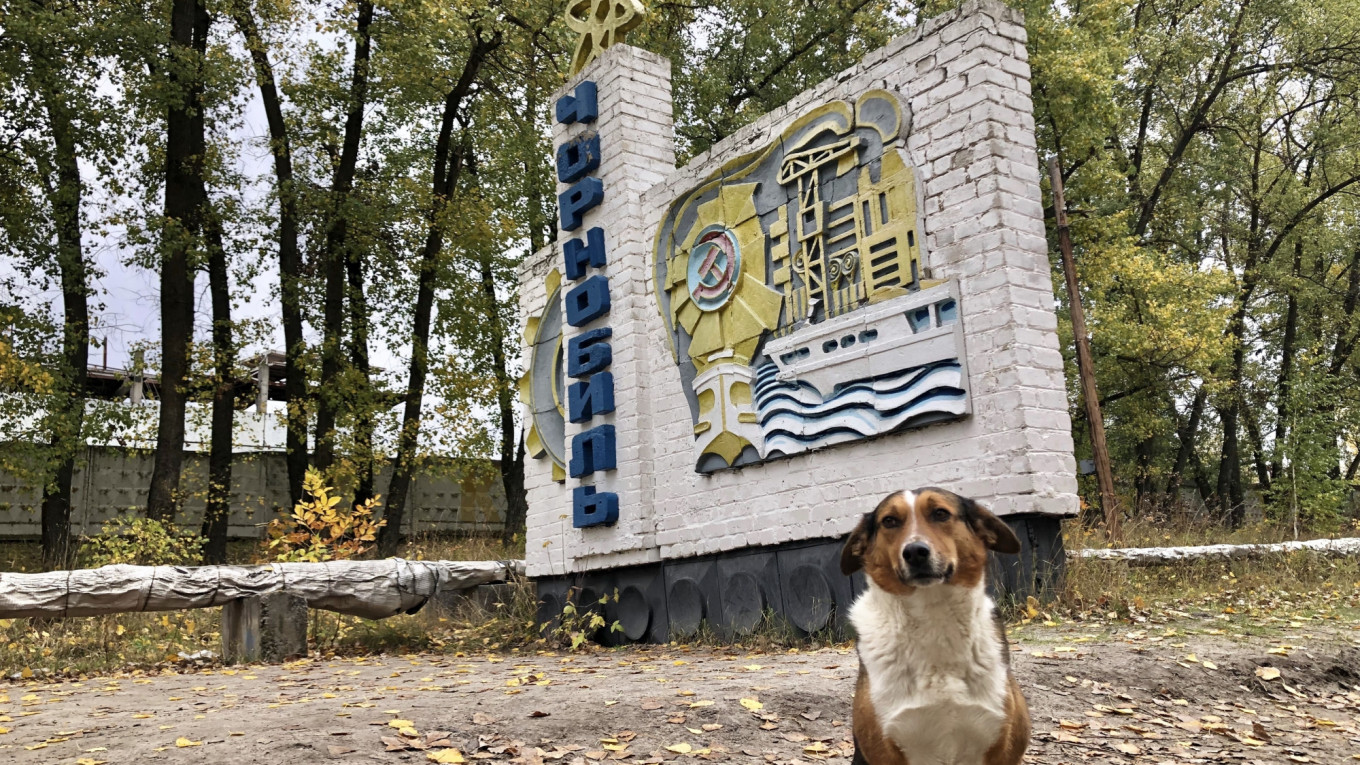CHERNOBYL, Ukraine — On a gray, overcast fall morning, a hound mix with copper-and-white fur sidles up to a group of foreign tourists taking photographs in front of the old Soviet sign welcoming visitors to Chernobyl.
“Dude, don’t touch it, you’ll start throwing up,” a brash college-age American says to his friend, laughing. “We just signed a form about this.”
“I feel like I’m going to cry,” says a 20-something woman in hiking clothes as the dog allows the bravest of the group to pet it. The dog calmly leans her head into a man’s leg as he scratches her ears and the ruff around her neck. After a few minutes, she saunters off the road and into the forest, quiet as a ghost.
Hundreds of dogs inhabit the exclusion zone that covers a 30-kilometer radius around Chernobyl in northern Ukraine. They are the descendants of the pets left behind in 1986, when more than 100,000 people were evacuated after the catastrophic explosion at the city’s nuclear power plant. Soviet soldiers tried to kill as many of the animals as possible to stop them from spreading radiation, but they couldn’t get to all of them.
More than three decades later, the dogs’ biggest threat to survival isn’t radiation, but wild animals, disease and the bitter Ukrainian winter. Few live beyond 4-5 years.
There had been virtually no organized efforts to help the dogs, whose numbers had climbed to over 1,000 by 2013. Workers maintaining the sarcophagus containing the plant’s old reactor and local residents fed them scraps when they could, but it wasn’t enough, and rabies, overpopulation and malnourishment were rampant.
These locals told Lucas Hixson and Erik Kambarian, co-founders of the U.S.-based Clean Futures Fund NGO, that they needed help caring for the dogs and controlling numbers through humane methods. They formed a partnership with SPCA International (SPCAI), an animal aid NGO, and the Dogs of Chernobyl project was born in 2017.

The project’s first priority was to vaccinate and sterilize at least 70% of the dogs within three years, a goal that was met this summer.
“Even if you went in one year and vaccinated all 1,000 dogs, by year two there would be 200 or 300 more that would need to be vaccinated again,” Hixson said. “That’s why sterilization is so important for humane population control.”
For Dr. Jennifer Betz, Dogs of Chernobyl’s veterinary medical director, the most obvious challenge — and fear — during the project was radiation. But most of the radiation is in the dogs’ fur, she said, and usually washes off with soap and water.

It hasn’t all been smooth sailing.
While some dogs allowed people to approach them, others were afraid of or aggressive toward humans. Local residents and workers were also initially skeptical toward the project’s volunteers, who were a mix of U.S. and Ukrainian veterinary workers.
“You have to prove yourself and show that you are a legitimate organization,” said Meredith Ayan from SPCAI. “They care about these animals very deeply, which is why the program started in the first place.”
Each dog caught by volunteers is checked for radiation, then spayed or neutered, vaccinated and given any other needed care. They’re then given small tattoos and dosimeter ear tags so they can be tracked over time. Because the dog population in Chernobyl is so isolated, the teams were able to bring the number of new litters of puppies down to virtually zero, Betz said.
“To run a regular spay-and-neuter program anywhere in the world takes a lot of effort … To do that in the place with the worst radiation in the world seems like it would have been impossible,” said SPCAI’s Lori Kalef.
As the danger posed by radiation has subsided, tourism to Chernobyl has steadily risen. Things really took off, however, when HBO’s miniseries “Chernobyl” debuted this spring. Tour companies operating in the exclusion zone said demand was up by about 40% this summer compared to last year.
With this influx of tourists — many of whom weren’t alive when the disaster happened — has come a new interest in the dogs and their well-being, Ayan said. One of the most-discussed episodes of the miniseries shows the Soviet animal extermination.
“We were happy to see that. It wasn’t a pleasant storyline and it wasn’t easy to watch, but the dogs were included,” Ayan said. “Having that conversation definitely raised awareness.”
Last year, Dogs of Chernobyl was able to convince the Ukrainian government to allow some of the dogs to be adopted in North America. Only dogs younger than one year were eligible, as volunteers had to prove that the dogs being adopted weren’t contaminated.
Jackie Mahler was approved to adopt a Chernobyl puppy last October. The dog, named Isotope, now lives in Washington, D.C., and Mahler calls her the “sweetest dog I’ve ever met.”
“I had been to the exclusion zone when I was last in Ukraine and fell in love with the dogs there,” she said. “When I heard about this opportunity, I knew it was something like fate.”
The adoption program has been hugely popular — Hixson says the project received over 1,000 applications for 50 or so dogs — but the challenges of bringing dogs out of the zone make it unlikely to happen again.
The project’s goal now is to make sure the remaining dogs are continuously given the food and medical care they need to have healthy, fulfilled lives.

When it first came to Ukraine, Clean Futures Fund planned to work with humans, not animals. More than 3,500 people go to work inside the exclusion zone every day and several hundred people live there, with thousands more living in towns outside the zone.
“Our mandate is to help communities that are affected by industrial accidents,” Hixson said. “So our reach actually extends outside of the 30-kilometer zone.”

By vaccinating the dogs against diseases like rabies, the program is combatting the biggest safety threat to residents, workers and tourists in the zone, Hixson said.
“Ukraine gets its rabies vaccine for humans from Russia, but because of the war, they haven’t been receiving an adequate supply for six years now,” he said, referring to the conflict between pro-Russian separatists and the Ukrainian government in Donbass. “So if somebody is bitten by a dog that potentially has rabies, it’s a very big safety issue.”
The program also has an impact on the community’s emotional health by ensuring that people working in and living around the Chernobyl exclusion zone can keep enjoying the close companionship they have with the dogs. There were multiple culls of animals after 1986 and no one wanted to have to witness another one.
As for co-founder Hixson, he’s happy to have put a system of humane population control in action. He adopted one of the dogs and named her Dvaa, the Ukrainian word for “two,” as she was the second dog to be treated at the Dogs of Chernobyl veterinary center.
“She chose me,” he said.
A Message from The Moscow Times:
Dear readers,
We are facing unprecedented challenges. Russia's Prosecutor General's Office has designated The Moscow Times as an "undesirable" organization, criminalizing our work and putting our staff at risk of prosecution. This follows our earlier unjust labeling as a "foreign agent."
These actions are direct attempts to silence independent journalism in Russia. The authorities claim our work "discredits the decisions of the Russian leadership." We see things differently: we strive to provide accurate, unbiased reporting on Russia.
We, the journalists of The Moscow Times, refuse to be silenced. But to continue our work, we need your help.
Your support, no matter how small, makes a world of difference. If you can, please support us monthly starting from just $2. It's quick to set up, and every contribution makes a significant impact.
By supporting The Moscow Times, you're defending open, independent journalism in the face of repression. Thank you for standing with us.
Remind me later.







